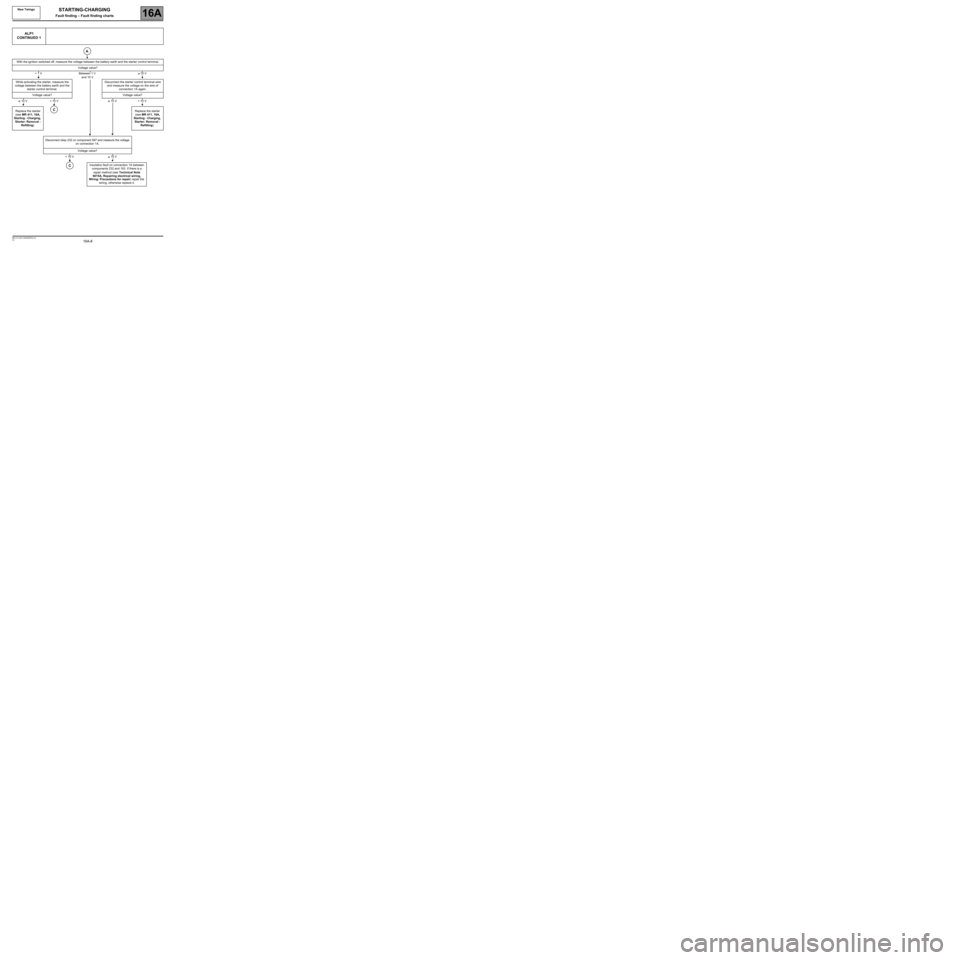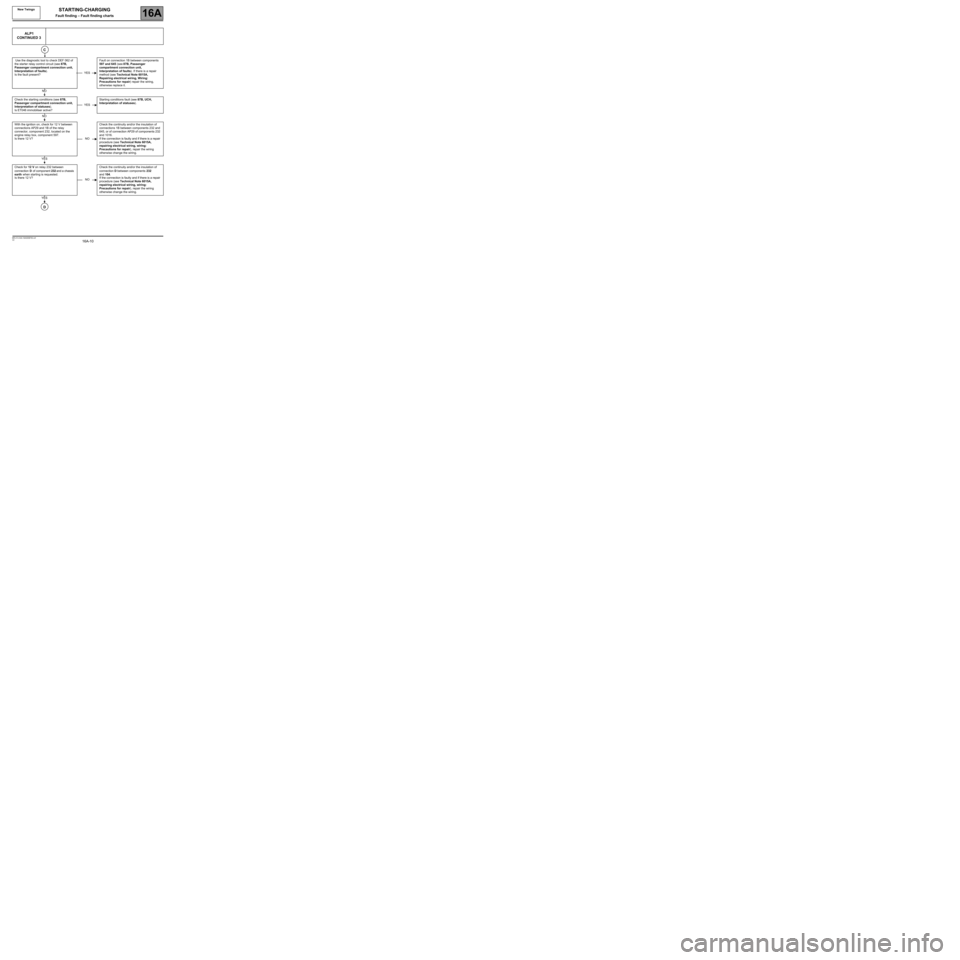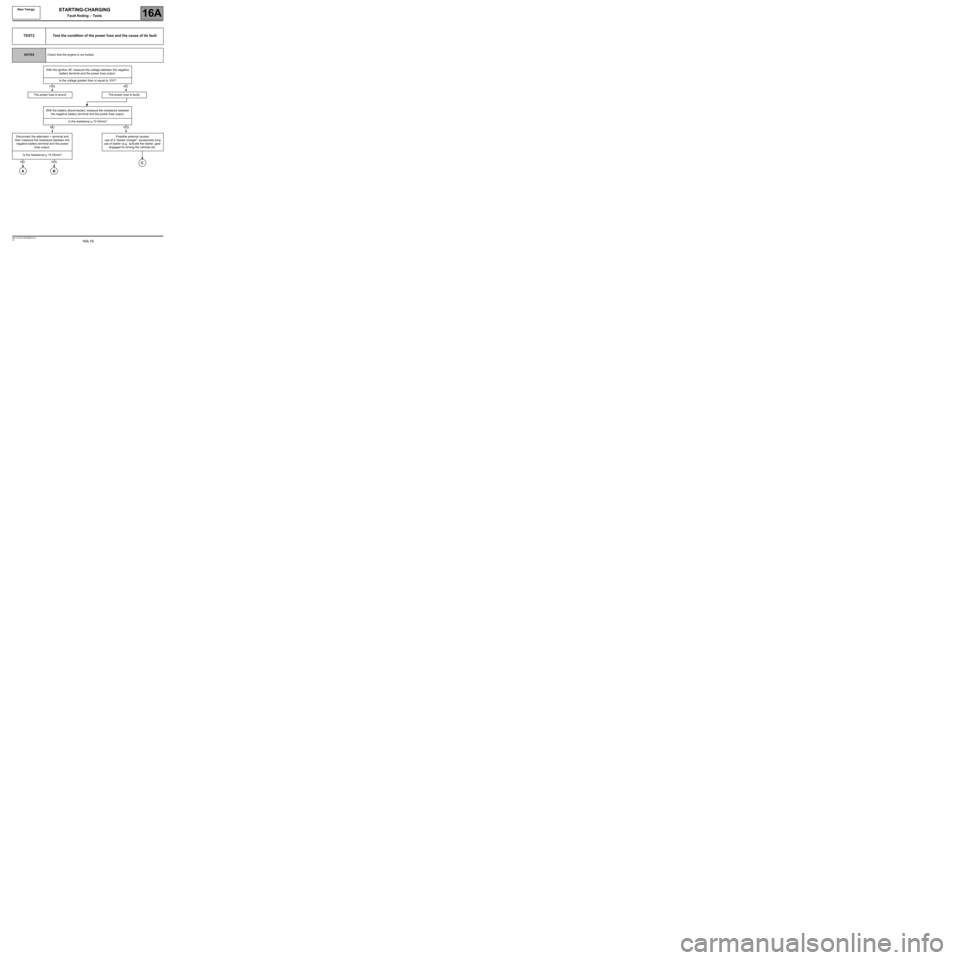ignition RENAULT TWINGO RS 2009 2.G Engine Starting Charging Workshop Manual
[x] Cancel search | Manufacturer: RENAULT, Model Year: 2009, Model line: TWINGO RS, Model: RENAULT TWINGO RS 2009 2.GPages: 22
Page 3 of 22

16A-3
MR-413-X44-16A000$250.mif
V2
16A
STARTING-CHARGING
Fault finding – Role of components
●Battery
The principal purpose of the battery is to provide the powerful current briefly required by the starter motor to start the
engine. For optimum starting, the current supplied by the battery must be sent to the starter motor with minimum
loss. To achieve this, the electrical connections (wires, terminals, connectors, etc.) must be in good condition.
When the engine is not running, the battery must feed the accessories that operate constantly, even with the ignition
switched off, such as the alarm, radio codes, computers, etc.
●Alternator
The alternator only operates when the engine is running. Its function is to recharge the battery, and at the same time
to supply the electrical power required to operate all the electrical accessories on the vehicle.
The alternator fitted to the New Twingo is a controlled alternator. The UCH controls the regulation by means of a
serial connection (BSS).
●UCH
The UCH is linked to the alternator by a serial connection (BSS connection). The UCH and the alternator
communicate via this connection.
The UCH intelligently manages the alternator regulation voltage according to the engine phase, battery charge and
temperature.
●Starter
This turns the engine over to make it start, and requires a very powerful electric current, which the battery must be
able to supply.New Twingo
MR-413-X44-16A000$250.mif
Page 5 of 22

16A-5
MR-413-X44-16A000$500.mif
V2
16A
STARTING-CHARGING
Fault finding – Features
The function of the charging circuit is to:
●Ensure electrical energy is supplied to the vehicle whilst respecting the dynamic performance constraints
of the engine and transmission assembly: the alternator resisting torques and the torque gradients
measured must be managed.
●To control alternator loading and load shedding during engine management authorisation or variation of
the electrical load.
●To ensure the quality of the on board network voltage in terms of the voltage level and variation
(voltage gradient management).
●To optimise the battery charge by applying a voltage to its terminals correlating to its initial charge status
(in sleep mode) and to its internal temperature.
●To inform the engine management about the mechanical power taken from the accessories pulley,
the alternator charge rate and the rotor excitation current value.
●To run fault finding on the charging circuit: “Battery” warning light display.
The function of the starting circuit is to:
●Start the vehicle during a starting request with the ignition key if necessary. New Twingo
MR-413-X44-16A000$500.mif
Page 8 of 22

16A-8V2 MR-413-X44-16A000$750.mif
STARTING-CHARGING
Fault finding – Fault finding charts16A
New Twingo
ALP1
CONTINUED 1
With the ignition switched off, measure the voltage between the battery earth and the starter control terminal.
Voltage value?
While activating the starter, measure the
voltage between the battery earth and the
starter control terminal.Disconnect the starter control terminal wire
and measure the voltage on the wire of
connection 1A again.
Voltage value? Voltage value?
Replace the starter
(see MR 411, 16A,
Starting - Charging,
Starter: Removal -
Refitting).Replace the starter
(see MR 411, 16A,
Starting - Charging,
Starter: Removal -
Refitting).
Disconnect relay 232 on component 597 and measure the voltage
on connection 1A.
Voltage value?
Insulation fault on connection 1A between
components 232 and 163. If there is a
repair method (see Technical Note
6015A, Repairing electrical wiring,
Wiring: Precautions for repair) repair the
wiring, otherwise replace it.
A
< 1 VBetween 1 V
and 10 V≥ 10 V
≥ 10 V< 10 V
C
≥ 10 V< 10 V
< 10 V
C
≥ 10 V
Page 10 of 22

16A-10V2 MR-413-X44-16A000$750.mif
STARTING-CHARGING
Fault finding – Fault finding charts16A
New Twingo
ALP1
CONTINUED 3
Use the diagnostic tool to check DEF 062 of
the starter relay control circuit (see 87B,
Passenger compartment connection unit,
Interpretation of faults).
Is the fault present?Fault on connection 1B between components
597 and 645 (see 87B, Passenger
compartment connection unit,
Interpretation of faults). If there is a repair
method (see Technical Note 6015A,
Repairing electrical wiring, Wiring:
Precautions for repair) repair the wiring,
otherwise replace it.
Check the starting conditions (see 87B,
Passenger compartment connection unit,
Interpretation of statuses).
Is ET046 immobiliser active?Starting conditions fault (see 87B, UCH,
Interpretation of statuses).
With the ignition on, check for 12 V between
connections AP29 and 1B of the relay
connector, component 232, located on the
engine relay box, component 597.
Is there 12 V?Check the continuity and/or the insulation of
connections 1B between components 232 and
645, or of connection AP29 of components 232
and 1016.
If the connection is faulty and if there is a repair
procedure (see Technical Note 6015A,
repairing electrical wiring, wiring:
Precautions for repair), repair the wiring
otherwise change the wiring.
Check for 12 V on relay 232 between
connection D of component 232 and a chassis
earth when starting is requested.
Is there 12 V?Check the continuity and/or the insulation of
connection D between components 232
and 104.
If the connection is faulty and if there is a repair
procedure (see Technical Note 6015A,
repairing electrical wiring, wiring:
Precautions for repair), repair the wiring
otherwise change the wiring.
C
YES
NO
YES
NO
NO
YES
NO
YES
D
Page 19 of 22

16A-19V2 MR-413-X44-16A000$875.mif
STARTING-CHARGING
Fault finding – Tests16A
New Twingo
TEST2 Test the condition of the power fuse and the cause of its fault
NOTESCheck that the engine is not locked
With the ignition off, measure the voltage between the negative
battery terminal and the power fuse output.
Is the voltage greater than or equal to 10V?
The power fuse is sound The power fuse is faulty
With the battery disconnected, measure the resistance between
the negative battery terminal and the power fuse output.
Is the resistance
≥ 10 Ohms?
Disconnect the alternator + terminal and
then measure the resistance between the
negative battery terminal and the power
fuse output.Possible external causes:
use of a "starter charger", excessively long
use of starter (e.g.: activate the starter, gear
engaged for driving the vehicle) etc.
Is the resistance
≥ 10 Ohms?
YESNO
NOYES
CNO
A
YES
B